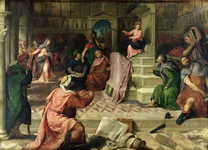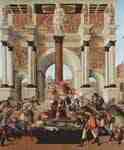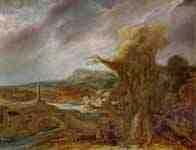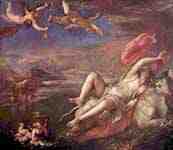Isabella Stewart Gardner Museum, Boston

The Child Jesus Disputing in the Temple, Paris Bordone

Death of Lucretia, Sandro Botticelli

Portrait of Rodrigo de Almada, Albrecht Dürer

Landscape with Obelisk, Rembrandt Harmensz. van Rijn

Rape of Europa, Titian

Harmony in Blue and Silver: Trouville, James Abbott McNeill Whistler
The Isabella Stewart Gardner Museum (ISGM) or Fenway Court, as the museum was known during Isabella Stewart Gardner's lifetime, is a museum in the Fenway-Kenmore neighborhood of Boston, Massachusetts, located within walking distance of the Museum of Fine Arts (although the Museum of Fine Arts's Huntington Avenue location was constructed after Fenway Court) and near the Back Bay Fens. The museum houses an art collection of world importance, including significant examples of European, Asian, and American art, from paintings and sculpture to tapestries and decorative arts. In 1990, thirteen of the museum's works were stolen; the high-profile crime remains unsolved and the artwork's location is still unknown.
Today, the museum hosts exhibitions of historic and contemporary art, as well as concerts, lectures, family and community programs, and changing courtyard displays. In accordance with the will of Isabella Stewart Gardner, admittance is discounted to those wearing Boston Red Sox memorabilia, and is free to anyone named Isabella.
History
The museum was incorporated in 1900 and opened in 1903 by Isabella Stewart Gardner (1840–1924), an American art collector, philanthropist, and patron of the arts. It is housed in a building designed to emulate a 15th-century Venetian palace, drawing particular inspiration from the Venetian Palazzo Barbaro.
Gardner began collecting seriously after she received a large inheritance from her father in 1891. Her purchase of Vermeer's The Concert at auction in Paris in 1892 was her first major acquisition. In 1894, Bernard Berenson offered his services in helping her acquire a Botticelli. With his help, Gardner became the first American to own a painting by the Renaissance master. Berenson helped acquire nearly 70 works of art for her collection.
The Rape of Europa (1562) by Titian is one of the most famous works in the museum.
After her husband John L. Gardner's death in 1898, Isabella Gardner realized their shared dream of building a museum for their treasures. She purchased land for the museum in the marshy Fenway area of Boston, and hired architect Willard T. Sears to build a museum modeled on the Renaissance palaces of Venice. Gardner was deeply involved in every aspect of the design, though, leading Sears to quip that he was merely the structural engineer making Gardner's design possible. After the construction of the building was complete, Gardner spent a full year carefully installing her collection in a way that evokes intimate responses to the art, mixing paintings, furniture, textiles and objects from different cultures and periods among well-known European paintings and sculpture. The gallery installations were very different than they appear today. The Room of Early Italian Paintings, for example, served as her Chinese Room until about 1914.
The museum opened on January 1, 1903 with a grand celebration featuring a performance by members of the Boston Symphony Orchestra and a menu that included champagne and doughnuts.
During Gardner's lifetime, she welcomed artists, performers, and scholars to Fenway Court to draw inspiration from the rich collection and dazzling Venetian setting, including John Singer Sargent, Charles Martin Loeffler, and Ruth St. Denis, among others. Gardner also occasionally hosted artists' exhibitions within Fenway Court, including one of Anna Coleman Ladd. Today, the museum's contemporary artist-in-residence program, courtyard garden displays, concerts, and innovative education programs continue Isabella Gardner's legacy.
When Isabella Stewart Gardner died in 1924, her will created an endowment of $1 million and outlined stipulations for the support of the museum, including the charge that her collection be permanently exhibited "for the education and enjoyment of the public forever" according to her aesthetic vision and intent. Gardner stipulated that if her wishes for the museum were not honored, the property and collection were to be sold and the money given to Harvard University.
Gardner appointed her secretary and the former librarian of the Museum of Fine Arts, Boston, Morris Carter (1877-1965) as the museum's first director. Carter catalogued the entire collection and wrote Gardner's definitive biography, Isabella Stewart Gardner and Fenway Court. George L. Stout (1897-1978), Monuments Man, served as the museum's second director. The father of modern conservation, Stout insured the long-term preservation of the collection and historic structure. Rollin Van Nostrand Hadley (1927-1992) became the museum's third director in 1964. Leaving the museum with a mixed legacy in 1988, Hadley published several catalogues and articles about the collection during his tenure but also deaccessioned much of the museum's asian artwork in 1971.
The museum's current director is Anne Hawley, though she has announced plans to step down effective at the end of 2015.[2]
Design
Side view of original building shows glass skylights which illuminate the central atrium
Built to evoke a 15th-century Venetian palace, the museum itself provides an atmospheric setting for Isabella Stewart Gardner's inventive creation. Gardner hired Willard T. Sears to design the building near the marshy Back Bay Fens to house her growing art collection.[3] Inside the museum, three floors of galleries surround a garden courtyard blooming with life in all seasons.
It is a common misconception that the building was brought to America from Venice and reconstructed.[4] It was built from the ground up in Boston out of new materials, incorporating numerous architectural fragments from European Gothic and Renaissance structures.
Antique elements are worked into the design of the turn-of-the-century building. Special tiles were custom designed for the floors, modern concrete was used for some of the structural elements, and antique capitals sit atop modern columns. The interior garden courtyard is covered by a glass roof, with steel support structure original to the building.
The Gardner Museum is much admired for the intimate atmosphere in which its works of art are displayed and for its flower-filled courtyard. Most of the art pieces are unlabeled, and the generally low lighting is more akin to a private house than a modern art museum.
Collection
Sandro Botticelli, The Story of Lucretia (1496–1504)
Isabella Stewart Gardner collected and carefully displayed a collection of more than 2,500 objects—paintings, sculpture, furniture, textiles, architectural elements, drawings, silver, ceramics, illuminated manuscripts, rare books, photographs and letters—from ancient Rome, Medieval Europe, Renaissance Italy, Asia, the Islamic world, and 19th-century France and America. Among the artists represented in the galleries are Titian, Rembrandt, Michelangelo, Raphael, Botticelli, Manet, Degas, Whistler and Sargent. The first Matisse to enter an American collection is housed in the Yellow Room.
Well-known artworks in the museum's collection include Titian's The Rape of Europa, John Singer Sargent's El Jaleo and Portrait of Isabella Stewart Gardner, Fra Angelico's Death and Assumption of the Virgin, Rembrandt's Self-Portrait, Aged 23, Cellini's Bindo Altoviti, and Piero della Francesca's Hercules.
The archives hold more than 7,000 letters from 1,000 correspondents, including Henry Adams, T.S. Eliot, Sarah Bernhardt, and Oliver Wendell Holmes, in addition to travel albums, dealer receipts, and guest books.
The galleries also contain Isabella Stewart Gardner's little-known but extensive book collection that includes early-print editions and manuscripts of Dante, works by miniaturist Jean Bourdichon, incunables, and illuminated manuscripts.
Extension and preservation project
View of original building from inside the new wing. A glassed-in passageway connecting the buildings is visible at lower center of photo.
In 2002, after a two-year master planning process, the museum's board of trustees determined that a new wing was necessary to preserve the historic building and to provide improved spaces for programs that continue Isabella Gardner's legacy. In 2004, Pritzker Prize–winning architect Renzo Piano and the Renzo Piano Building Workshop (Genoa, Italy) were selected to design the new wing. The design for the new wing is conceived as a respectful complement to the historic Museum building in scale, form, and materials.
In March 2009, the Supreme Judicial Court of Massachusetts approved the museum's plans, confirming that the project is consistent with the primary purpose of Isabella Stewart Gardner's will and is in the public interest. The project also received approval from all relevant city and state preservation and development review agencies.
The new expansion includes spaces for visitor services, concerts, special exhibitions, and education and landscape programs, furthering Isabella Gardner's legacy in art, music, and horticulture while reducing 21st-century strain on the collection and galleries. The completion date was 2012,[5] and the project cost $118 million.[6]
Art theft of 1990
Announcement on stolen masterpieces from the museum.
Main article: Isabella Stewart Gardner Museum theft
In the early morning hours of March 18, 1990—when the city was preoccupied with Saint Patrick's Day celebrations—a pair of thieves disguised as Boston police officers gained entry to the museum and stole thirteen works of art.
The total worth of the stolen pieces has been estimated at $500 million, making the robbery the greatest single property theft in US history.[7] Several empty frames hang in the Dutch Room gallery as placeholders for the missing works, in hopeful expectation of their return. The selection of stolen works puzzled experts, as more valuable artworks were present in the museum.[8]
Some of the artworks stolen in 1990
The Concert
(c. 1658–1660)
by Vermeer
A Lady and Gentleman in Black (1633)
by Rembrandt
The Storm on the Sea of Galilee (1633)
by Rembrandt
Landscape with an Obelisk (1638)
by Govert Flinck
Chez Tortoni
by Édouard Manet
La Sortie de Pesage
by Degas
Current programs
The Gardner Museum regularly produces scholarly exhibitions—along with lectures, family programs, and symposia—that provide insights into the historic collection. Through the Gardner's Artist-in-Residence program, artists in many disciplines are invited to live at and draw inspiration from the museum. The museum often hosts exhibitions of contemporary art, performances, and programs by Artists-in-Residence.
The Gardner's concert series welcomes musicians and emerging artists to perform classical masterpieces, new music, and jazz on Sunday afternoons and select Thursday evenings. The musical program is also available through concert videos, audio recordings, and a free classical music podcast.
Reflecting Isabella Gardner's passion for horticulture and garden design, the Gardner's interior courtyard is an astonishing work of art, combining ever-changing horticultural displays with sculpture and architectural elements. The unique interplay between the courtyard and the museum galleries offers visitors a fresh view of the courtyard from almost every room, inviting connections between art and landscape. Programs like the Landscape Visions lecture series and special Ask the Gardener hours further engage visitors with the art of landscape.
The Gardner offers a variety of admission discounts. Because Isabella Gardner was a Red Sox fan, visitors wearing Red Sox paraphernalia receive an admission discount. Also in honor of its founder, the museum offers free admission and occasional special events for anyone named Isabella. In addition, visitors receive free admission to the museum on their birthday.[9]
Recent exhibitions
Exhibitions
Following is a list of the Gardner's exhibitions since 2002.[10]
| Exhibition Title | Date |
|---|---|
| Cosme Tura: Painting and Design in Renaissance Ferrara | January 30 – May 12, 2002 |
| Making of the Museum: Isabella Stewart Gardner as Collector, Architect, and Designer | April 23 – August 24, 2003 |
| Raphael, Cellini and a Renaissance Banker: The Patronage of Bindo Altoviti | October 8, 2003 – January 11, 2004 |
| Gondola Days: Isabella Stewart Gardner and the Palazzo Barbaro Circle | April 21 – August 15, 2004 |
| Off the Wall: New Perspectives on Early Italian Art at the Gardner Museum | October 6, 2004 – January 9, 2005 |
| Gentile Bellini and the East | December 14, 2005 – March 26, 2006 |
| A Bronze Menagerie: Mat Weights of Early China | October 5, 2006 – January 14, 2007 |
| Luxury for Export: Artistic Exchange between India and Portugal around 1600 | February 8 – May 4, 2008 |
| The Triumph of Marriage: Painted Cassoni of the Renaissance | October 16, 2008 – January 19, 2009 |
| Journeys East: Isabella Stewart Gardner and Asia | February 21 – May 31, 2009 |
| Modeling Devotion: Terra Cotta Sculpture in the Italian Renaissance | February 23 – May 23, 2010 |
| Illuminating the Serenissima: Books of the Republic of Venice | May 3 – June 19, 2011 |
| Anders Zorn: A European Artist Seduces America | February 28 – May 13, 2013 |
Contemporary art exhibitions
The Gardner has also hosted the following exhibitions of contemporary art.[11]
| Exhibition Title | Date |
|---|---|
| Danijel Zezelj: Stray Dogs | June 24 – August 21, 2005 |
| Variations On a Theme by Sol Lewitt and Paula Robison | September 23 – November 13, 2005 |
| A Pagan Feast | November 22, 2005 – January 8, 2006 |
| Henrik Håkansson: Cyanopsitta spixii Case Study #001 | June 30 – September 17, 2006 |
| Sculpture and Memory: Works from the Gardner and by Luigi Ontani | February 9 – May 6, 2007 |
| Stefano Arienti: The Asian Shore | June 29 – October 14, 2007 |
| Cliff Evans: Empyrean | November 9, 2007 – January 13, 2008 |
| Luisa Rabbia: Travels with Isabella, Travel Scrapbooks 1883/2008 | June 26 – September 28, 2008 |
| Su-Mei Tse: Floating Memories | July 16 – October 18, 2009 |
| Taro Shinoda: Lunar Reflections | November 5, 2009 – January 1, 2010 |
| Once | June 18–20, 2010 |
| Stefano Arienti: Ailanthus | 2012 |
| Points of View: 20 Years of Artists-in-Residence at the Gardner | January 19 – August 20, 2012 |
| (TAPESTRY) RADIO ON: New Work by Victoria Morton at the Gardner | January 19 – May 28, 2012 |
| Magic Moments: The Screen and the Eye–9 Artists 9 Projections | June 21 – August 20, 2012 |
| Luisa Lambri: Portrait | January 19 – October 15, 2012 |
| Raqs Media Collective: The Great Bare Mat and Constellation | September 20, 2012 – January 7, 2013 |
| Stefano Arienti: Wild Carrot | June 2012 – April 2013 |
| Untitled: Adam Pendleton | April – October 2013 |
| Sophie Calle: Last Seen | October 24, 2013 – March 3, 2014 |
| Carla Fernández: The Barefoot Designer: A Passion for Radical Design and Community | April 17 – September 1, 2014 |
See also
National Register of Historic Places listings in southern Boston, Massachusetts
References
"National Register of Historical Places: Massachusetts (MA), Suffolk County". National Register of Historic Places. National Park Service. March 11, 2007.
"Director of Isabella Stewart Gardner Museum Steps Down". Artforum. February 11, 2015. Retrieved February 11, 2015.
"ISGM Exhibitions: The Making of the Museum—Construction". Gardner Museum. Retrieved March 26, 2010.
Beagle, Ph.D., Jonathan M. (2013). Boston: A Visual History. Charlesbridge. p. 133. ISBN 978-1-60734-666-1.
Edgers, Geoff (November 29, 2004). "Gardner museum to grow". The Boston Globe. Retrieved January 21, 2010.
Edgers, Geoff (January 20, 2010). "Gardner's $118m expansion plan set". The Boston Globe. Retrieved March 26, 2010.
Rothman, Lily (18 March 2015). "American History’s Biggest Art Theft Hits 25 Years Unsolved". Time. Retrieved 23 March 2015.
McShane, Thomas & Matera, Dary (2006). "18. No Boston Tea Party at Isabella's". Stolen Masterpiece Tracker. Barricade Books. ISBN 978-1-56980-314-1.
"Plan a Visit – Offers and Discounts". Gardner Museum. Retrieved September 17, 2012.
"Isabella Stewart Gardner Museum: Past Exhibitions". Retrieved June 19, 2013.
"Isabella Stewart Gardner Museum: Contemporary Exhibitions". Retrieved June 19, 2
----
Fine Art Prints | Greeting Cards | Phone Cases | Lifestyle | Face Masks | Men's , Women' Apparel | Home Decor | jigsaw puzzles | Notebooks | Tapestries | ...
----
Artist
A - B - C - D - E - F - G - H - I - J - K - L - M -
N - O - P - Q - R - S - T - U - V - W - X - Y - Z
Retrieved from "http://en.wikipedia.org/"
All text is available under the terms of the GNU Free Documentation License


